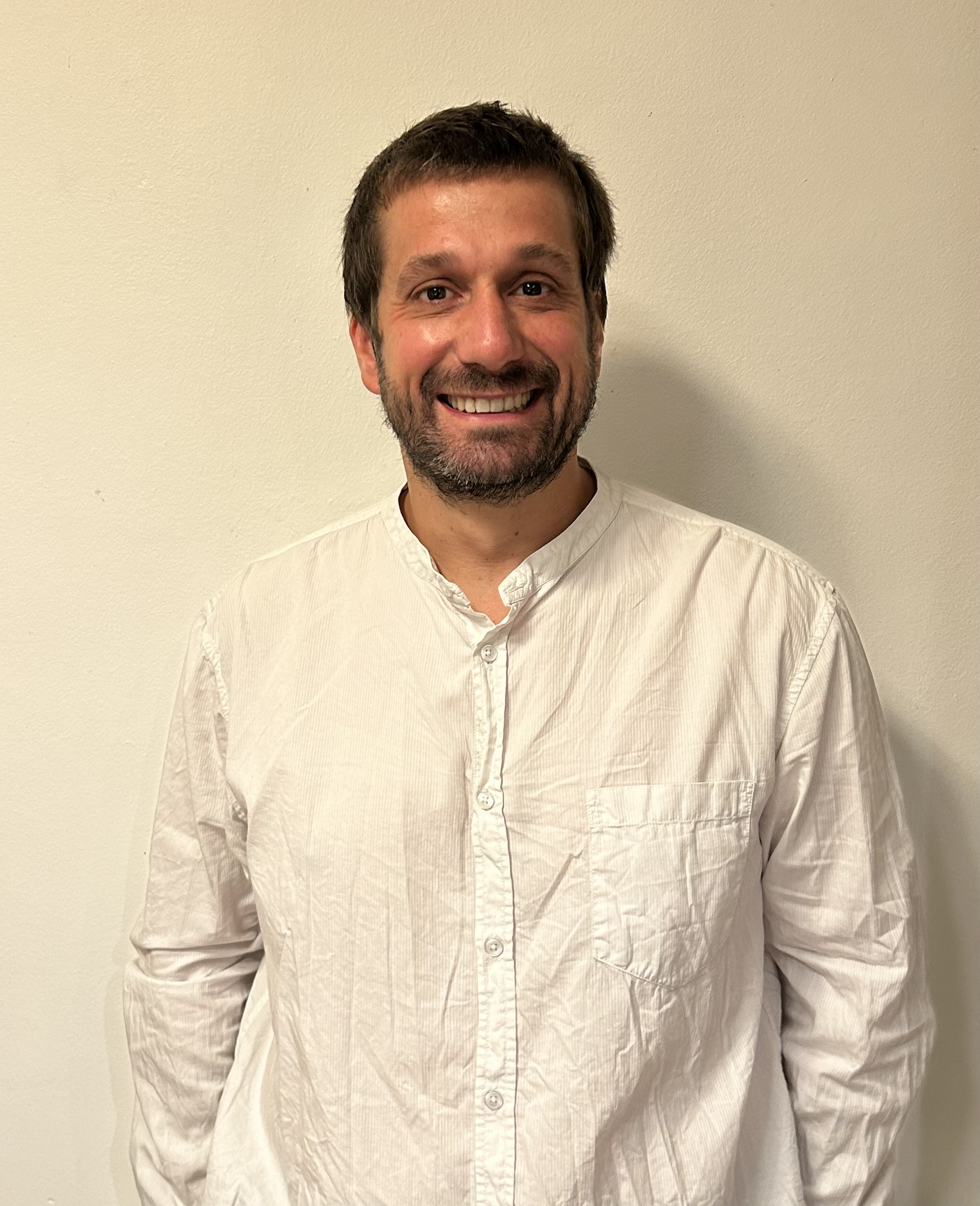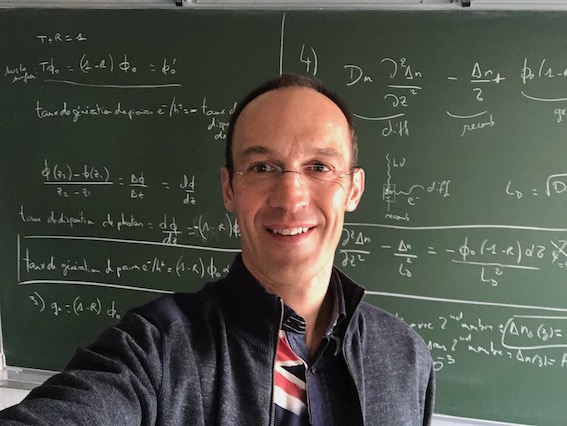Equipe Light Ultimate MatErials Nanodevices and PV (LUMEN-PV)
Responsable d'équipe-s :
David DUCHE
Responsable-adjoint-e-s :
Judikaël LE ROUZO
- Accueil
- Membre(s) de l'équipe :
- Publications
Campus de Polytech' Marseille
5 Rue Enrico Fermi - Bât. Néel

Research field in the LUMEN-PV Team
The LUMEN-PV team is specialized advanced characterization and simulation for the development opto-electronic devices.
The team is developing expertise in material science, in photonics and in optotoelectronics, and is focus in the fields of photovoltaics, rectennas, photodetectors, LEDs, LiFi, thermo-photovoltaics, with the mission of developing cutting-edge measurement benches and simulation models for thin-film optoelectronic components.
The research studies of the LUMEN-PV team is devided in two main activities ;
- Light management for organic solar cells and new PV concepts,
- Nanophotonic and photo-detection.
Highlights/actualités
2 start-ups coming from LUMEN-PV team
- 3L-Optronics : Deeptech company providing digital high performance dual day/night vision for automotive, smart cities, mobile phones
- Optipus-PV : We provide flexible solar modules that power product sustainably without compromising on design
Highlight Rectennas: Optoelectronic Devices from CNRS Sent into Space Aboard the ISS for the EMA (Euro Material Ageing) Experiment of CNES
https://cnes.fr/actualites/ema-mesurer-vieillissement-materiaux-lespace-liss
Ultra-high-frequency diodes, used in the fabrication of optical rectennas for space applications, have been sent into space aboard the ISS for a study on aging and reliability. This study, funded by CNES, is part of a collaborative R&T project that began in 2019, involving CNRS laboratories from IM2NP (Marseille), CINaM (Marseille), and LTM (Grenoble). The project is led by Dr. David Duché, a researcher at the IM2NP laboratory, in close collaboration with Dr. Cécile Gourgon, Research Director at LTM, and Prof. Olivier Margeat, a researcher at the CINaM laboratory.
Key Steps in the Space Deployment:
- Launch via SpaceX CRS-31 on November 4, 2024
- Preparation of the experiment on the ISS on December 13, 2024
- Installation on the exterior of the ISS on December 16, 2024
A la maison, vaut-il mieux aller sur internet via un réseau mobile ou avec sa box wifi?
par Pauline Bennet et Denis Langevin
GDR : Thermal Radiation to Electrical Energy conversion (TREE)
The third workshop TREE is planned to be organized from (2 PM) to (noon) 2025 in Lyon.
https://tree.ies.umontpellier.fr/
OPV: Organic solar cells with PCE > 20 % at a lab scale
Non-fullerene acceptors with high crystallinity and photoluminescence quantum yield enable >20% efficiency organic solar cells, Li, C., Song, J., Lai, H. et al. Nat. Mater. (2025). https://doi.org/10.1038/s41563-024-02087-5
https://www.nature.com/articles/s41563-024-02087-5/
Vidéos
Rectennas and molecular diodes
https://youtu.be/eSVw3K32cfc?si=mBynAr4gX-Fvol9r
https://amupod.univ-amu.fr/video/0561-etna-project-amidex-pr2i-energie/
https://www.youtube.com/watch?v=I4_GWEnFu34/
Optical geolocalisation whithout GPS
https://www.youtube.com/watch?v=l0IEVb4APRM
https://www.youtube.com/watch?v=Z87h2Kn6PVE/
Research activities in the LUMEN-PV team
Light management for organic solar cells and new PV concepts
-
Organic solar cells
Notre expertise en métrologie et en modélisation optique des matériaux pour le PV nous a permis de travailler sur de nombreuses structures de cellules solaires photovoltaïques à travers différents projets et collaborations (silicium, PV en couches minces, pérovskite, QDs).
Des premiers travaux en commun avec l’équipe FUN dans le cadre du projet FUI SFUMATO ont permis de mettre en avant les performances de l’équipe FUN sur la réalisation de cellules solaires organiques performantes (rendement supérieur à 9%, état de l’art sur les matériaux utilisés). Ces cellules ont pu être modélisées et caractérisées dans l’équipe LUMEN-PV afin de pouvoir optimiser ses propriétés optiques (prédiction de la couleur des dispositifs) et électriques.
Ce projet a donné lieu à un brevet et a abouti en 2016 à un projet européen Eurostars Polyomino qui a pour objectif la mise en place d’une plateforme d’impression numérique de cellules solaires organiques (partenaires : CSEM, Fluxim, Ardeje, Dracula Technologie).
Depuis janvier 2018, LUMEN-PV est partenaire du projet ANR NFA-15 (coordinateur J. Ackermann - CINAM) dans lequel nous avons comme objectif, avec l’aide en particulier de l’institut de Chimie de Clermont-Ferrand, d’étudier le vieillissement des cellules à base d’accepteurs non fullerènes. Notre contribution consiste à étudier l’évolution des propriétés optiques de ces nouveaux matériaux en combinant de l’ellipsométrie, de la spectrophotométrie UV-Vis, de la photoluminescence et du Raman.
Nous avons également développé une forte collaboration avec l'entreprise Dracula Technologies, sur la thématique des cellules solaires organiques tout imprimé. Dans ce cadre, un banc de mesures "Indoor" a été réalisé (photo du banc ci-dessous) afin d'étudier les propriétés des cellules solaires en environnement intérieur.
- IOPV-LAB : Developing PV for indoor energy harvesting
The rapid development of Internet of Things (IoT) technology has spurred increased research on energy sourcing for small and autonomous devices. Indoor photovoltaics offer an elegant solution by harnessing ambient light within their working environment. However, implementing photovoltaic systems under indoor conditions presents a double challenge to traditional PV: devices have to adapt to the different working conditions and a new characterization methodology has to be developed. The project IOPV-lab addresses both with the consortium Dracula Technologies, CINaM and IM2NP.
On this project LUMEN-PV team at IM2NP develops in collaboration with Dracula novel methods of characterization for the determination of performances of indoor PV devices. As opposed to traditional solar photovoltaics where the sun has a well-defined spectrum and energy power density, there is a wide range of ambient light sources which differ on their emission spectrum and also, the light flux received on the PV device can vary as a function of the light intensity and device position. To try to answer this variability of conditions, we have developed a characterization set-up where the flexibility is key, and allow to characterize the performances of the devices under a big range of light sources and the incident light power is controlled by the distance between source and device. Furthermore, the setup is equipped with a spectrophotometric system that allows the characterization of the light source at every moment.
Since July 2023, a new norm has been proposed by the IEC for indoor-PV characterization [1]. As a result, we are developing a new set-up that will conform to the specifications of said norm and will position our lab on the forefront of the indoor-PV metrology.
Furthermore, the indoor-PV community is starting to take form and both Dracula and Lumen-PV are an active part, participating on the first indoor-PV conference in Tampere, in July 2024 and also taking part in the ongoing discussion about the pertinence of developing a new methodology for assessing the performances of devices on ambient light conditions or keep with the traditional solar PV figures of merit.
[1] IEC TS 62607-7-2:2023 , Nano-enabled photovoltaics – Device evaluation method for indoor. IEC ,Geneva, Switzerland, 2023
- LIFI
Visible light communication systems (VLC or LiFi, depending on the application) enable wireless data transmission via HF modulation (invisible to the eye) of the light intensity produced by an LED transmitter. In the near future, these emerging technologies are expected to complement RF technologies such as WiFi, as the specific fields of application are numerous: indoor geolocation, secure transmissions, inter-vehicle communications. In addition, the development of autonomous connected objects (IoT) has brought with it the need not only to use new communication channels, but also to integrate energy recovery systems into these devices. It is in this context that two teams from the IM2NP laboratory (the LUMEN-PV team and the Signal and Tracking team) have been working closely together for the past 6 years on the study of solar cells as VLC receivers. An experimental bench (based on the OFDM communication protocol) was developed during Nominoë Lorrière's PhD thesis. The results, carried out in collaboration with ARMOR and SOLAR FRONTIER companies, demonstrated the relevance of this PV solution compared with conventional receivers (photodiodes), particularly in high-light environments. Since 2022, Lisa Bouby's thesis has focused on coupling impedance spectroscopy measurements (electrical signals) and data reception measurements (light signals) on the same bench (Figure 1) using OFDM signals, in collaboration with DRACULA TECHNOLOGIES, with the ultimate goal of combining a VLC data reception function and an energy recovery function in a single organic PV device obtained by inkjet printing technique. This work is funded as part of the ANR OPV4COM project (2024-2028) in collaboration with XLIM laboratory Limoges.
Nano-photonic and photo-detection
-
« Black Silicon »
Des travaux sur la structuration du silicium, sous la forme de nano ou micro-structures, sont également en cours, et ont permis d’obtenir des antireflets très performants (moins de 1% sur toute la gamme du visible). Un procédé breveté de texturation sans masque (Brevet WO2015186064 A1 : "Method for the random texturing of a semiconductor substrate") a été mis au point en utilisant la gravure ionique réactive (RIE). Ce procédé a permis de réaliser des cellules solaires IBC (Interdigitated Back Contacts) performantes ainsi que des photodétecteurs plus sensibles dans le proche infrarouge, en incluant une passivation de surface par ALD développée au CINAM.
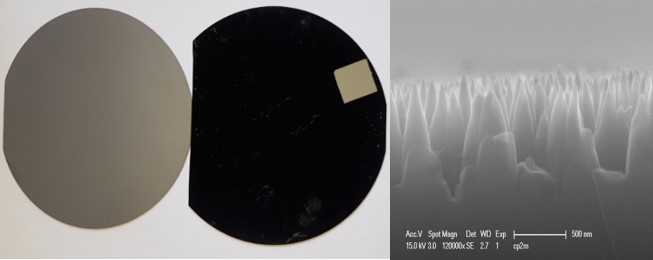
-
Rectennas : rectifying nano-antennas to harvest light energy and photodetection
The electronic mechanisms of a rectifying optical antenna, also called an optical rectenna, are similar to those involved during the reception of radio waves with conventional antennas. Electromagnetic waves (EM) at optical frequencies can be absorbed by a metallic nano-antenna and cause an oscillation of the conduction electrons in the metal which consecutively induces the generation of an AC1 current. The generated AC current has a high frequency (between 120 THz and 1015 Hz for the solar spectrum) and must be rectified with diodes to obtain a DC current. This technology presents two main advantages. The first one comes from the ability to convert electromagnetic waves into electricity from far infrared to the visible range with high-power conversion efficiency (PCE). The second advantage is related to the possibility of tuning the rectenna working spectral range to optimize PCE for any light source by simply adjusting the antenna geometry.
This method for high frequency rectification is not limited to the conversion of electromagnetic radiations coming from the sun or indoor artificial sources. Other important applications are related to the IR electromagnetic waves detection, to the wireless transmission of information and energy from THz to optical frequencies or to the conversion of radiated waste heat into electricity.
The main goal of the PLASMORE-LIGHT project is to establish a proof-of-concept and to develop rectennas exhibiting power efficiencies up to 1% under solar illumination and which can be adapted to operate in visible (400nm – 800nm) and near infrared (800nm – 2000nm). The rectenna architecture proposed in the PlasMORE-LIGHT project consist on the association of metallic nanopatch antennas with ultra-high speed molecular diodes.
[D. Duché et al, brevet EP17306695 - 2017]
[C. A. Reynaud et al, Adv. Optical Mater. 2018, 10.1002/adom.201801177].
Highlight Rectennas: Optoelectronic Devices from CNRS Sent into Space Aboard the ISS for the EMA (Euro Material Ageing) Experiment of CNES
https://cnes.fr/actualites/ema-mesurer-vieillissement-materiaux-lespace-liss
Ultra-high-frequency diodes, used in the fabrication of optical rectennas for space applications, have been sent into space aboard the ISS for a study on aging and reliability. This study, funded by CNES, is part of a collaborative R&T project that began in 2019, involving CNRS laboratories from IM2NP (Marseille), CINaM (Marseille), and LTM (Grenoble). The project is led by Dr. David Duché, a researcher at the IM2NP laboratory, in close collaboration with Dr. Cécile Gourgon, Research Director at LTM, and Prof. Olivier Margeat, a researcher at the CINaM laboratory.
Key Steps in the Space Deployment:
- Launch via SpaceX CRS-31 on November 4, 2024
- Preparation of the experiment on the ISS on December 13, 2024
- Installation on the exterior of the ISS on December 16, 2024
The assembly aboard the ISS was carried out by american astronauts Sunita Williams and Don Pettit, with installation using the robotic arm on the Airbus Bartolomeo external platform. In the photo below, the red arrow highlights the ultra-fast diode devices developed as part of the project and sent into space. The project coordinator, Dr. David Duché, expressed his excitement about seeing his work deployed in such a setting and eagerly awaits the return of his samples to Earth!
- Plasmonic biosensors
Plasmonic resonators composed of metallic nanocubes deposited on a gold layer have the unique ability to strongly confine the electromagnetic field in the resonator. The field beneath the cube, present in the form of a gap-plasmon, is highly sensitive to the resonator's surroundings. The LUMEN-PV team is exploring the potential of this sensitivity to develop innovative plasmonic biosensors for diagnostics, meeting the ASSURED criteria (Affordable, Sensitive, Specific, User-friendly, Rapid/Robust, Equipment-free, Deliverable).
By adding a functionalization layer to the metallic surface, we can detect biologically relevant molecules. When target molecules are captured by the functionalization layer, it induces a change in the optical index of the layer surrounding the resonator. This alteration in optical index leads to a measurable modification in the resonator’s optical response, allowing us to determine the quantity of detected biological molecules. We characterize, model, and finely optimize the optical response of these resonators to identify the best parameters (resonator size, type of functionalization layers...) for designing sensors that are more sensitive, more specific, and easier to manufacture.
As part of this interdisciplinary project, the LUMEN-PV team collaborates with several research groups in the frame of the SWAG-P ANR project: CINaM for the synthesis and deposition of nanocubes, ICR for the synthesis of functionalization layers, Institut Pascal for the modeling and optimization of devices, and INRIA for the modeling of complex structures.
-
Optical geolocalisation without GPS
SKYPOLE: Locating North By Sky Light
As part of Thomas Kronland-Martinet's PhD thesis and in the frame of a collaboration between IM2NP and ISM laboratories at Aix-Marseille University, we developed a method to determine the geographic north and our latitude using the polarized light from the sky, during the day. This method is inspired by migratory birds, which use the celestial rotation of stars at night to determine the position of the celestial pole. To measure and map the degree and direction of polarization of the sky, we use a focal-plane division polarimetric camera. To process the camera data, we apply the least-squares method to match the camera image with a simulated sky polarization image, and we use a neural network on the simulated images to extract the necessary information to detect the celestial pole. From this, we finally deduce our latitude, corresponding to the elevation of the celestial pole, as well as geographic north. This method has the advantage of requiring no data other than the polarization of the sky, but it does require separate measurements over time by a stationary observer.
[1] Kronland-Martinet, T., Poughon, L., Pasquinelli, M., Duché, D., Serres, J. R., & Viollet, S., “SkyPole—A method for locating the north celestial pole from skylight polarization patterns.,” PNAS. 30, 20 (2023). Doi : 10.1073/pnas.2304847120
[2] Kronland-Martinet, T., Poughon, L., Moutenet, A., Pasquinelli, M., Duché, D., Serres, J. R., and Viollet, S. “Locating the North Celestial Pole from Skylight Polarization Patterns and Solar Declination”. Under review at IEEE Transactions on Instrumentation andMeasurement (2024)
[3] Kronland-Martinet, T., Pasquinelli, M., Duché, D., Serres, J. R., & Viollet, S., “Procédé de détermination des invariances temporelles du degré de polarisation linéaire dans le ciel”, brevet (2023) (being extended internationally)
-
Absorbeurs optiques
L’équipe collabore étroitement avec la société Thalès Optronique depuis 2002 (thèses, contrats de collaboration, ANR, DGA) sur des fonctions optiques de types antireflet et filtres spectraux. L’intérêt est maintenant porté sur l’étude de couches hétérogènes constituées d’une matrice hôte et de nanoparticules métalliques ou diélectriques de formes complexes (ellipsoïdes, prismatiques ou tétrapodes par exemple) qui peuvent apporter une diffusion dans des angles particuliers et permettre un contrôle angulaire de l’absorption lumineuse. Les domaines d’intérêt touchent le solaire thermique et photovoltaïque (absorbeurs sélectifs, antireflets, oxydes conducteurs transparents rugueux, etc…) ainsi que l’optoélectronique (revêtements optiques spéciaux, photodétecteurs plus sensibles, discrétion optique, etc…). Ces recherches ont débuté dans la cadre de la thèse DGA de M. Carlberg (2014-2017) et en collaboration avec Thalès.
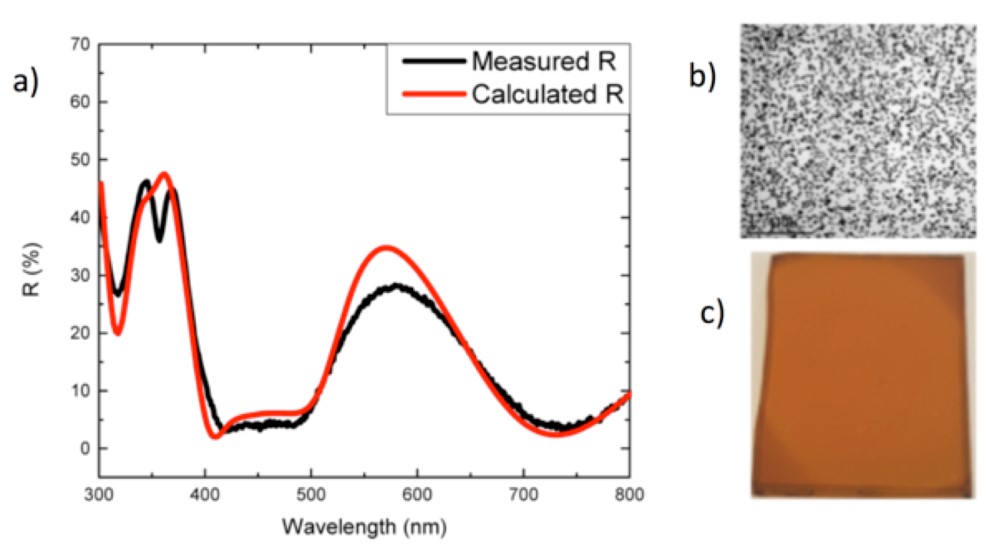
Projets scientifiques
En cours
Projet ANR OPV4COM (2025-2029), Projet Astrid ECOPOL (2025-2029), Projet ANR SWAG-P (2024-2028), Projet SMART4MODULE (PEPR TASE) (2024-2028), Projet ANR Monopoly (2023-2027), Projet ANR PlasMORELight (2021-2025)
Passés
Projet AMIDeX BSI (2022-2024); Projet CNES accepté dans le cadre de l’appel à idées R&T 2019 ; Contrat de Collaboration Dracula Technologies (OPV Indoor), 2017-2024 ; Collaboration sous NDA avec Solar Frontier, ARMOR et Dracula Technologies ; Projet Européen EUROSTAR : POLYOMINO (Platform of OPV modules), 2016-2019 ; Projet ANR NFA15 (Non-Fullerene-Acceptor), 2017-2021 ; Etna (AMIDEX) ; Projet ANR QUEPHELEC (2014-2017) ; Kestcells (Europe : http://kestcells.eu/); N-POEM (ANR : http://www.agence-nationale-recherche.fr/Projet-ANR-10-NANO-0016); SFUMATO (FUI),
Equipe commune FUN-PV
Depuis début 2015, notre équipe et l’équipe FUN (FUnctional Nanomaterials) du CINaM (http://www.cinam.univ-mrs.fr/cinam/team/immf/equipe-ackermann/) avons mené des discussions visant à élaborer un projet d’équipe commune ayant pour thématique l’électronique organique. Dans ce contexte, et depuis 2017, une convention CNRS entre nos 2 équipes a permis la création de l’équipe inter-instituts FUN-PV.
Cette volonté de rapprochement des deux équipes est motivée par un travail commun de quatre ans en tant que partenaires dans le projet FUI SFUMATO (cellules solaires organiques produites par impression numérique) couronné par des succès scientifiques communs (brevet + 3 publications à fort et très fort impact Sol. Mat, AEM, AFM), une réelle complémentarité en termes de compétences et de moyens et enfin une vision commune des orientations scientifiques du domaine des dispositifs PV couches minces et des composants optoélectroniques. En couplant des compétences très complémentaires (synthèses chimique et physique des matériaux nano-structurés, élaboration de dispositifs en couches minces, modélisations optoélectroniques, caractérisations physiques) et en partageant des moyens technologiques performants (depuis la synthèse de matériaux à la réalisation des dispositifs) avec un accès aux plateformes PLANETE (CINaM), SPRINT (IM2NP) et NANOTECMAT (IM2NP), cette équipe commune IM2NP/CINAM permet de positionner l’Université d’Aix-Marseille comme un acteur majeur de la recherche en PV hybride/organique au niveau international.
Mots clefs
Cellules photovoltaïques, antenne, rectenna, diode moléculaire, black silicon, photodétecteurs, LiFi, silicium, organique, Hybride, modélisation, réalisations, caractérisations optiques et électriques, micro/nano structuration des matériaux, antireflets structuraux, optique guidée et intégrée, nanophotonique
Equipements spécifiques :
- Plateforme de micro/nanotechnologies NANOTECMAT : Salle blanche (photomasqueur, gravure plasma et humide, lithographie LASER, «spin coating», microscope optique, profilomètre, insolation holographique, dépôt de métaux) ; évaporations sous vide ; Fours de recuits sous flux de gaz
- Plateforme SPRINT (Electronique Imprimée) : Profilomètre optique, Boîte à gants, Impression Jet d’encre.
- Mesures optiques : Photoluminescence, MicroRAMAN, Ellipsomètrie, C-AFM sous éclairement, Photoréflectance, Diffusomètre , Spectrophotomètre (UV-Vis-IR)
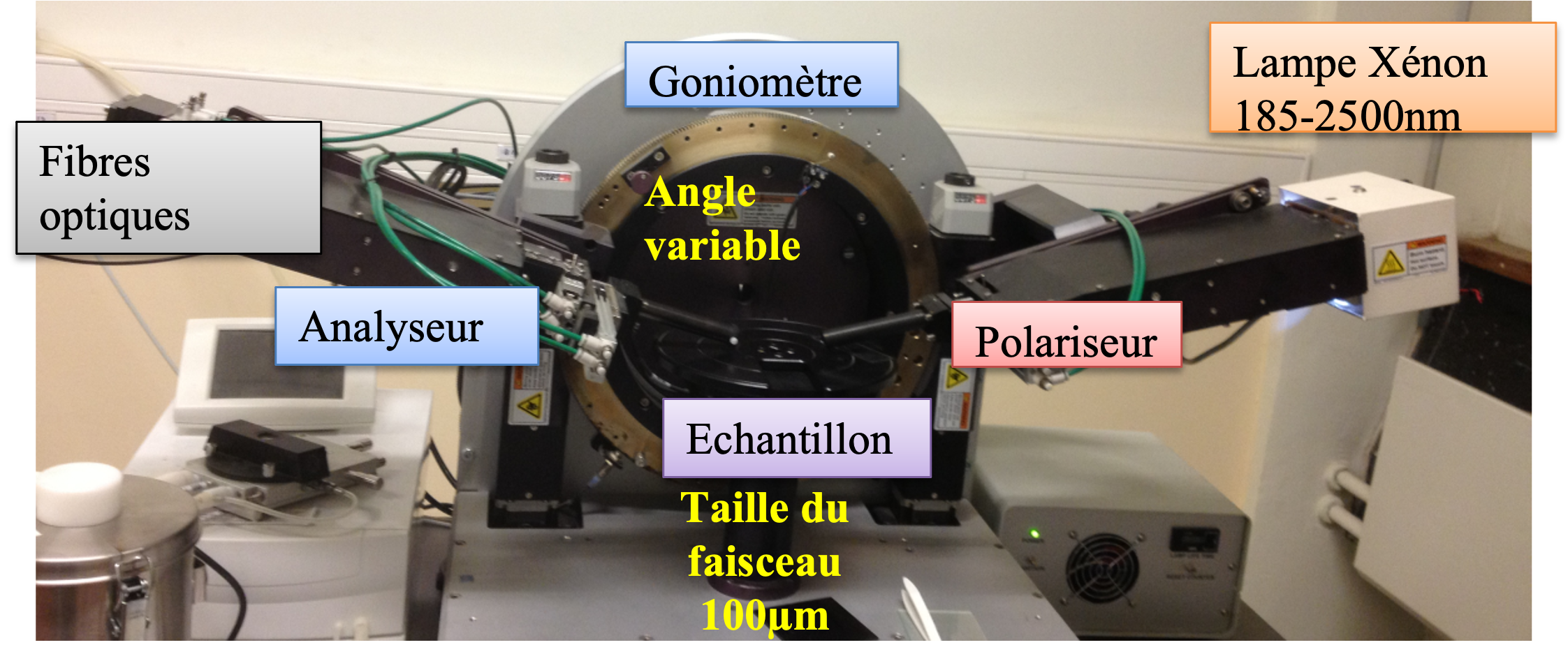
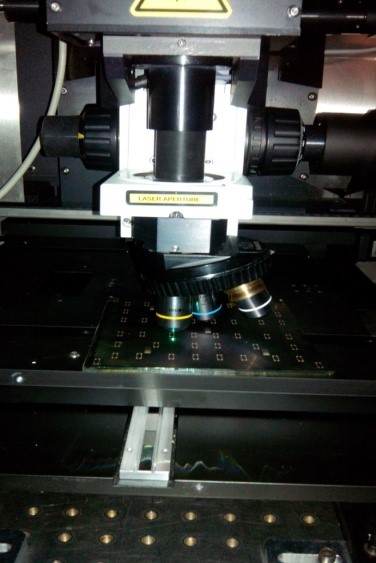
- Mesures électriques : Réponse spectrale (EQE, IQE), IV, CV et CV(T° et f), Résistivité 4 pointes ; Mesures Effet Hall (en T°); Simulateur solaire.
- Banc LiFi
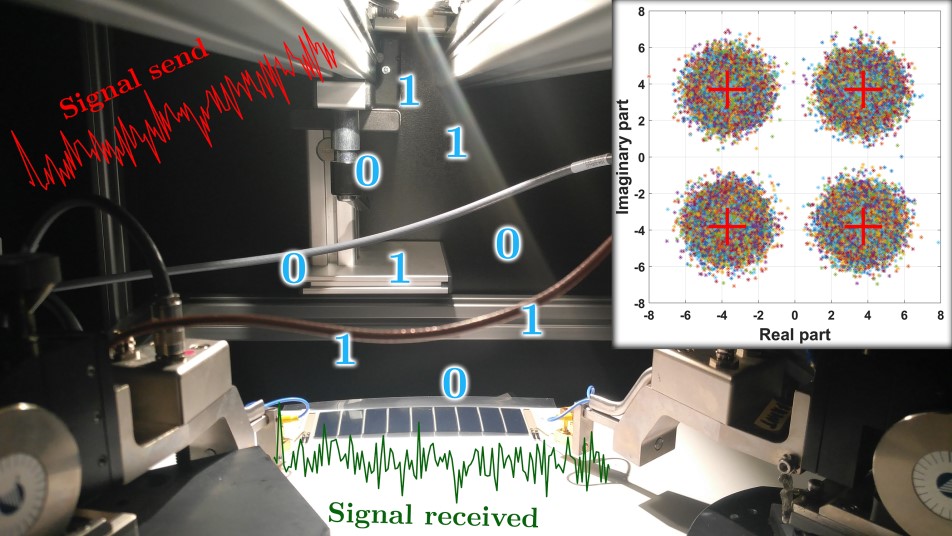
- Banc PV Indoor (collaboration DT)
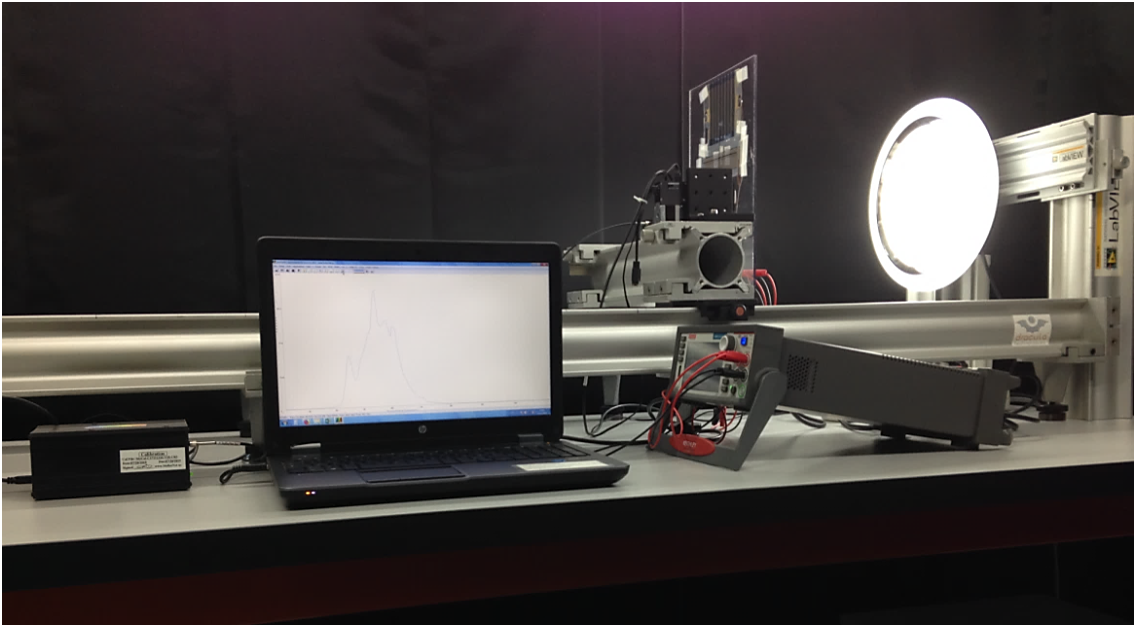
- Caractérisations électriques par technique EGaIn de diodes moléculaires
Collaborations
-
- National : CEA (INES, LITEN, LETI, SPRAM), CINAM, Madirel, IMS, LPICM, GEEPS, LCMTR, ICube , SYMME, LCPO, IPVF, XLIM , LTM, Institut Saint Louis, DGA, Pop Sud, pôle de compétitivité Optitec «Systèmes complexes d’optique et d’imagerie», pôle de compétitivité SCS, pôle de compétitivité Capénergie
- International : IREC (Barcelone), Angström Lab (Uppsala), Helmholtz Zentrum Berlin, National Central University (Taïwan), Sao Paolo University, Université de Tizi Ouzou (Algérie), Université de Ziguinchor (Sénégal).
- Industriels : Thales, ARMOR, Dassault Systemes, Dracula technologies, RTM, Ardeje, Fluxlim, Photowatt, IPVF, 3-Ohm PGC, Winlight systems.
David DUCHE
Maître de Conférences
Ludovic ESCOUBAS
Professeur AMU
Yves FAURE
permanent
Judikaël LE ROUZO
Professeur AMU
Marcel PASQUINELLI
permanent
Jean-Jacques SIMON
permanent
Carmen Maria RUIZ HERRERO
permanent
Pauline BENNET
permanent
Halidou ABDOUL YASSET
Non permanent
Lisa BOUBY
Non permanent
Lydia ABBASSI
Non permanent
Maurgène GHEZAL
Non permanent
ESTEBAN MONSALVO
Non permanent
Publications
| Publications |
|---|

